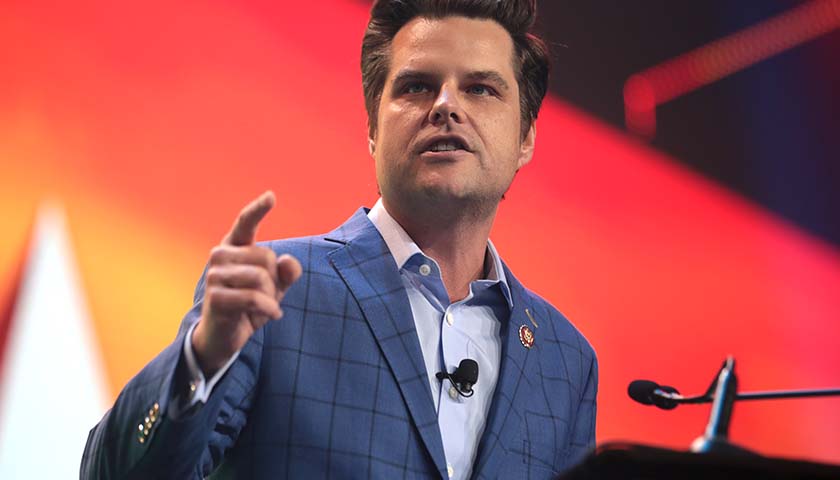by Tom Raabe
In a move eerily reminiscent of the failed Solyndra, President Joe Biden’s Department of Energy has doled out massive loans in green energy initiatives to corporations.
Remember Solyndra? Way back in 2009, the administration of Barack Obama, newly inaugurated and stoked with the ideological fire of environmental zeal, greenlit a $535 million loan guarantee to a company by that name to mass produce easy-to-install cylindrical solar units.
It was the poster child of Obama’s initiative to grow clean-tech jobs, the model for his administration’s effort to pump $80 billion into the green energy sector. To plump the program, the president made a flashy appearance at Solyndra’s factory in Fremont, California, just months prior to the 2010 midterms, saying that investing in clean energy is “the right thing to do for our environment, it’s the right thing to do for our national security, but it’s also the right thing to do for our economy.”
For American taxpayers, though, investing in Solyndra was the wrong thing to do. A little over a year after Obama’s visit, the firm shut down its hi-tech cylindrical photovoltaic fabrication plant and laid off most of its 1,100 workforce. Then it filed for bankruptcy and was raided by the FBI. Left holding a bag with $535 million in it were those same American taxpayers.
An investigation completed years later found that Solyndra had provided the government with “false and misleading information during the application process” and “that the actions of certain Solyndra officials were, at best, reckless and irresponsible or, at worst, an orchestrated effort to knowingly and intentionally deceive and mislead the Department.” It also discovered that the Energy Department’s “due diligence efforts were less than fully effective…. the Department missed opportunities to detect and resolve indicators that portions of the data provided by Solyndra were unreliable.” According to another report, one of the private investors backing the project was a big Obama fund-raising bundler.
It has also come out that White House insiders had warned the president beforehand of the perils of the Solyndra deal, telling him the company’s cost structure was unsound. But so great was his environmental ardor — or political ambition — that he ignored the advice and made the trip anyway.
The deal was a disaster all around — economically and politically.
Billions in Green Corporate Welfare
The government office that financed the Solyndra debacle is still around, now bigger, more aggressive, and much wealthier than it was then.
Founded in 2005 to pump up green energy with low-interest loans to environmental entrepreneurs, the Department of Energy’s Loan Programs Office has languished for a decade and a half — practically mothballed during the Trump years — until 2021, when Biden assumed office. Compliments of his “Trillions in Government Spending Reduces Inflation Act” (aka the Inflation Reduction Act), Biden pumped $350 billion into the office’s previous loan authority of $44 billion, and the office now has $394 billion to throw at green-energy firms to work toward the carbon-neutral-nation utopia.
Overseeing the cascade of money is Jigar Shah, who earned his environmental bona fides co-helming a start-up solar-energy firm called SunEdison in 2003. Under Shah (pictured above), the loan office will be financing the usual green projects — car-battery research, wind, and solar research — but it will also be pumping money into less mainstream endeavors, like producing hydrogen from natural gas, mining lithium, and producing graphite, an often-overlooked mineral used in rechargeable car batteries.
Already out Shah’s door is $9.2 billion, sent to Ford Motor Company to build EV battery plants in Tennessee and Kentucky. This marks the largest allotment of department largesse so far, and it has met with unlikely opposition — from the unions. EV plants require fewer jobs — and lower-paying ones, at that — than do the legacy car manufacturers, and the United Auto Workers is unhappy about it. Already irritated that General Motors closed its Lordsburg, Ohio, factory a few years ago only to have union jobs replaced with lower-paying jobs at the resultant factory producing battery cells, the UAW has been lobbying the administration to link the loans to companies’ willingness to be organized by labor, since EV manufacturing probably means fewer line workers than are needed to build internal combustion cars and trucks. Unlike other national unions, the UAW has yet to endorse for reelection the president, who calls himself a “car guy.”
UAW President Shawn Fain said in a statement:
We have been absolutely clear that the switch to electric engine jobs, battery production and other EV manufacturing cannot become a race to the bottom. Not only is the federal government not using its power to turn the tide – they’re actively funding the race to the bottom with billions in public money…. Why is Joe Biden’s administration facilitating this corporate greed with taxpayer money?
Other beneficiaries of the Energy Department’s spending spree include GM ($2.5 billion to build three battery-cell factories); PG&E, the California utility ($7 billion to bury power lines to avoid a future Camp Fire, the name given the wildfire that obliterated the town of Paradise in 2018, killing 84, to which PG&E later pled guilty in court); and a host of smaller start-ups, like Li-Cycle Holdings, a battery-recycling plant that got $375 million.
‘Solyndra on Steroids’
The Republican chair of the House Energy and Commerce Committee, Rep. Cathy McMorris Rodgers (R-Wash.), called Biden’s loan program “Solyndra on steroids” and vowed vigorous oversight of these huge loan outlays. She said:
The hardworking people of this country are paying for record high energy and food prices because of President Biden’s war on American energy. They cannot afford for him to waste hundreds of billions of dollars on a political agenda that forces an expensive ‘green’ energy transition, threatens energy reliability, increases costs, and makes America reliant on the Chinese Communist Party for batteries and solar panels. Energy and Commerce Republicans will hold DOE accountable for every cent spent to ensure taxpayer dollars are not wasted and the American people are protected.
Shah and his office may not feel the heat yet, but they seem to feel the urgency. After all, an election looms a mere 16 months away, and a change of White House occupant could mean the loan office funds drying up quicker than a desert gully washer. From a mere dozen employees when Shah stepped into his job in 2021, the loan office now boasts more than 200 staffers bustling to throw billions in loans at green projects across the U.S.
Why all this corporate welfare? Why isn’t private enterprise doing this?
Shah had an answer for that. Talking to the Wall Street Journal’s Kate Linebaugh, he said this:
Yes, yes, it should be coming from the private sector, but our entire career is a testament to the private sector not wanting to do this stuff. And so my hope is the private sector puts us out of a job because Lord Almighty, if you talk to our applicants, they would much prefer a streamlined process through the private sector than the bureaucratic process that I’m forced to do here at the Loan Programs Office. They’re in my office because the private sector won’t step up.
And why is that, you wonder? Could it be that America is not buying the climate change hysteria? Climate change came in tied for 15th, at 2 percent, in a Statistica poll from June 2023 of America’s most-pressing issues. It ranked well below “the government/poor leadership,” which led the field with 19 percent and trailed such concerns as the economy (13 percent), immigration (13 percent), and crime (6 percent).
Could it be that Americans want to preserve an energy system that has made their country the greatest in the world and makes everyday living convenient and economical? Could it be they are fully aware that an all-EV America is an impossibility? Could it be that, even should America achieve the Biden administration’s fanciful goal of carbon neutrality by 2050, the world’s temperature will hardly budge — if it budges at all? (Watch Sen. John Kennedy’s amusing interchange with Deputy Energy Secretary David Turk.) Could it be that in 2050, while America is awash in solar panels and windmills and EVs, China will be a dominant military power whose air quality is such that you still can’t see across the street in Beijing?
And could it be that they don’t want any more Solyndras?
– – –
Tom Raabe is a writer and editor living in Tempe, Arizona.




